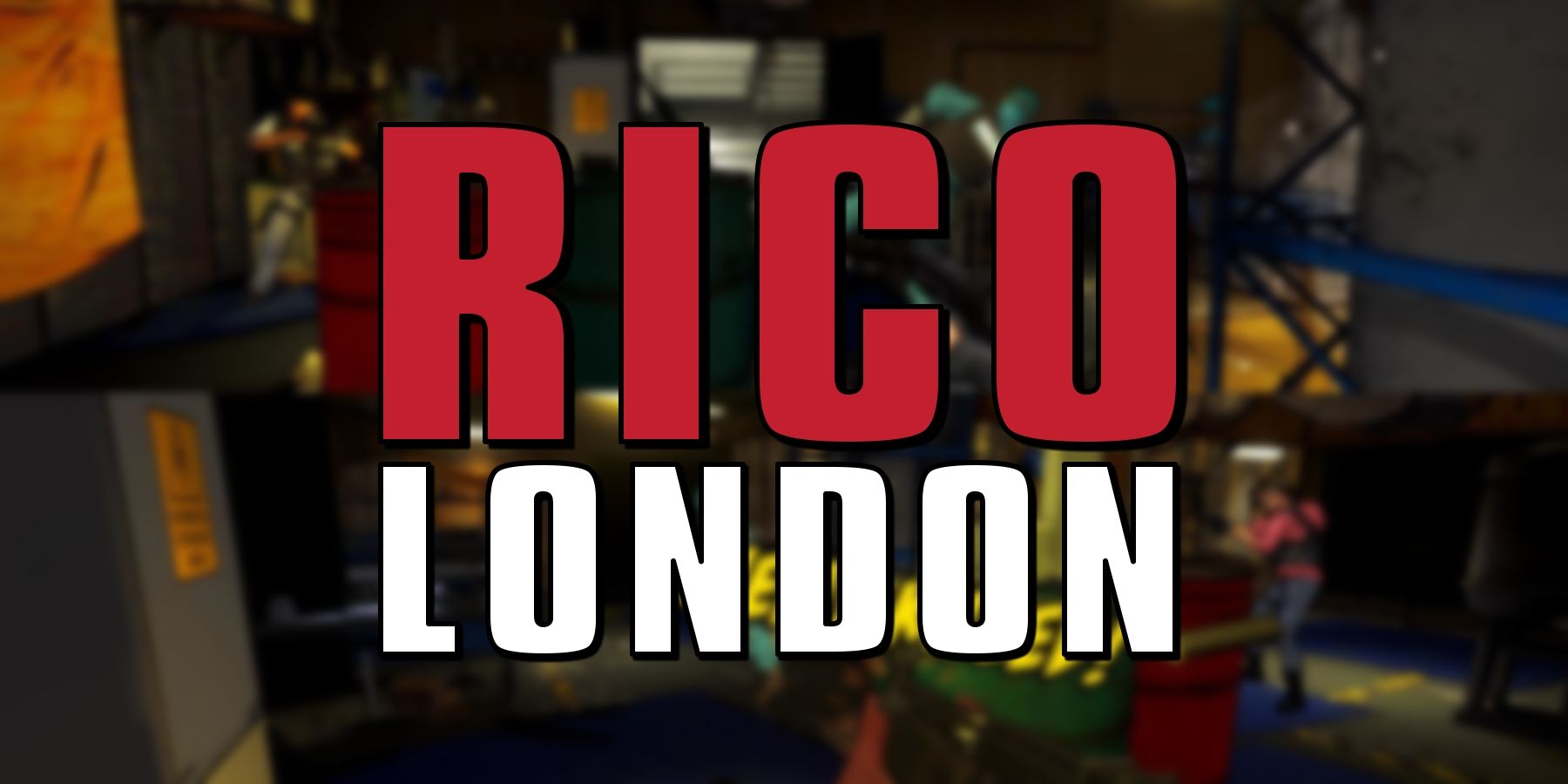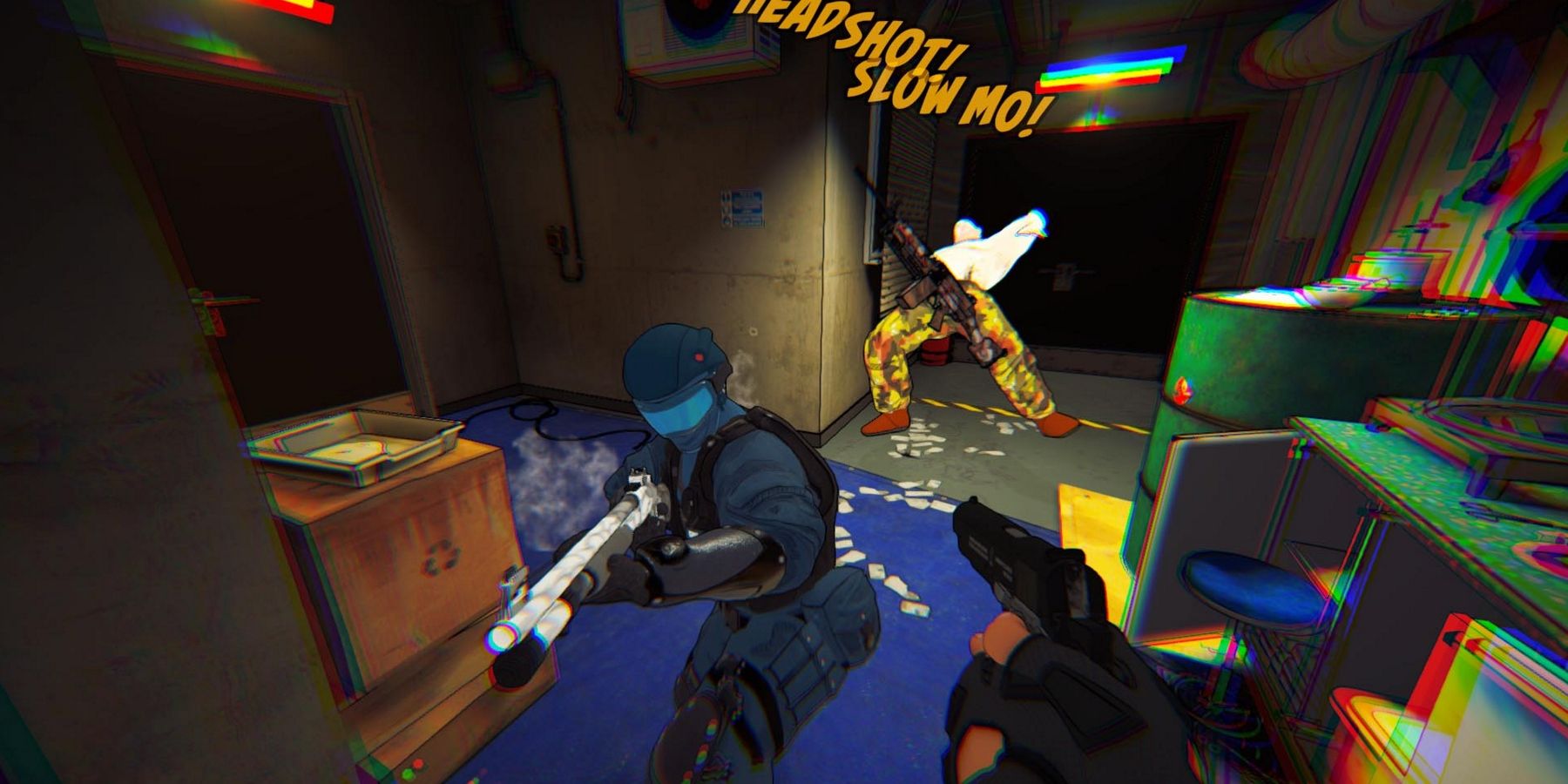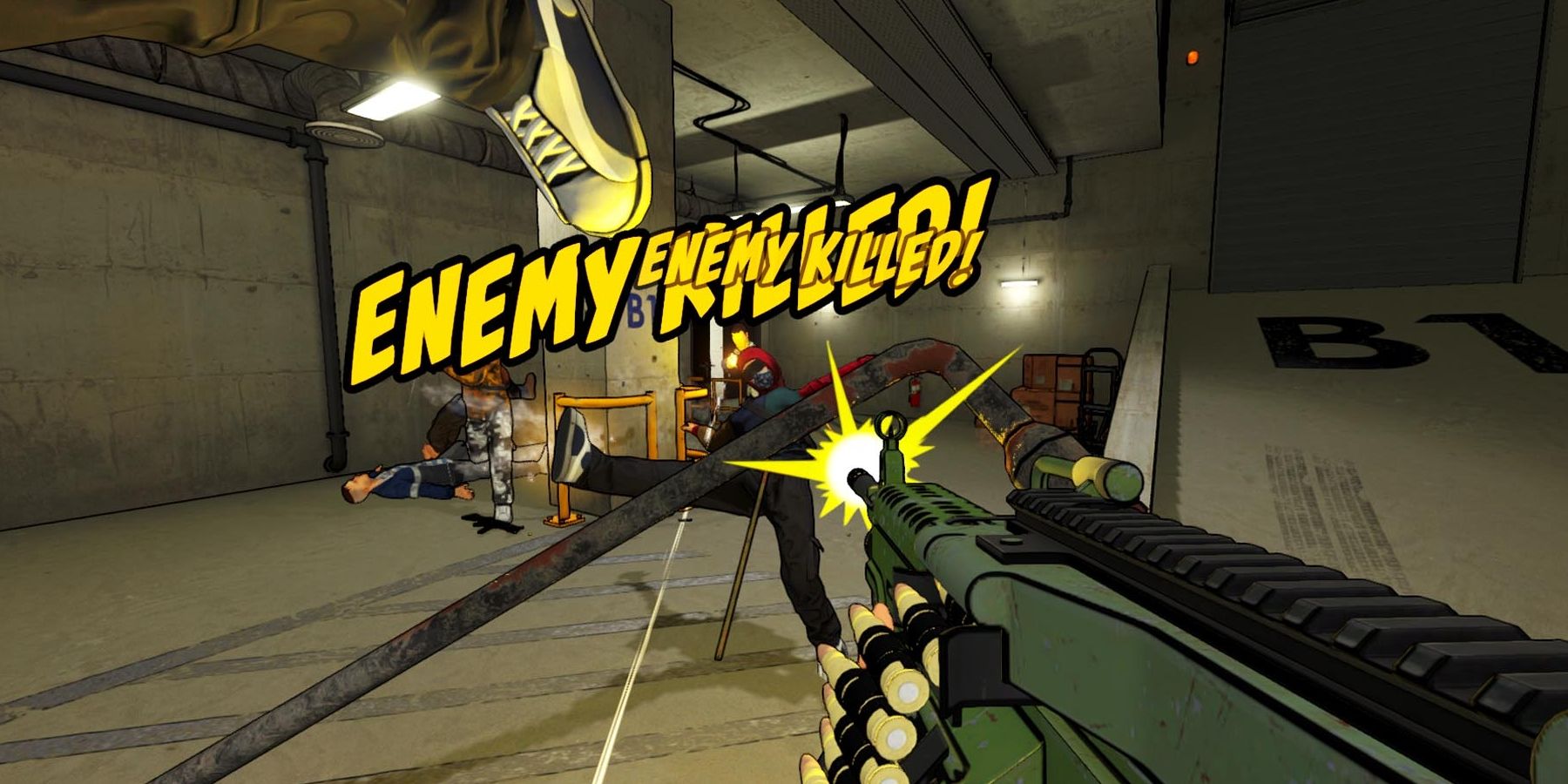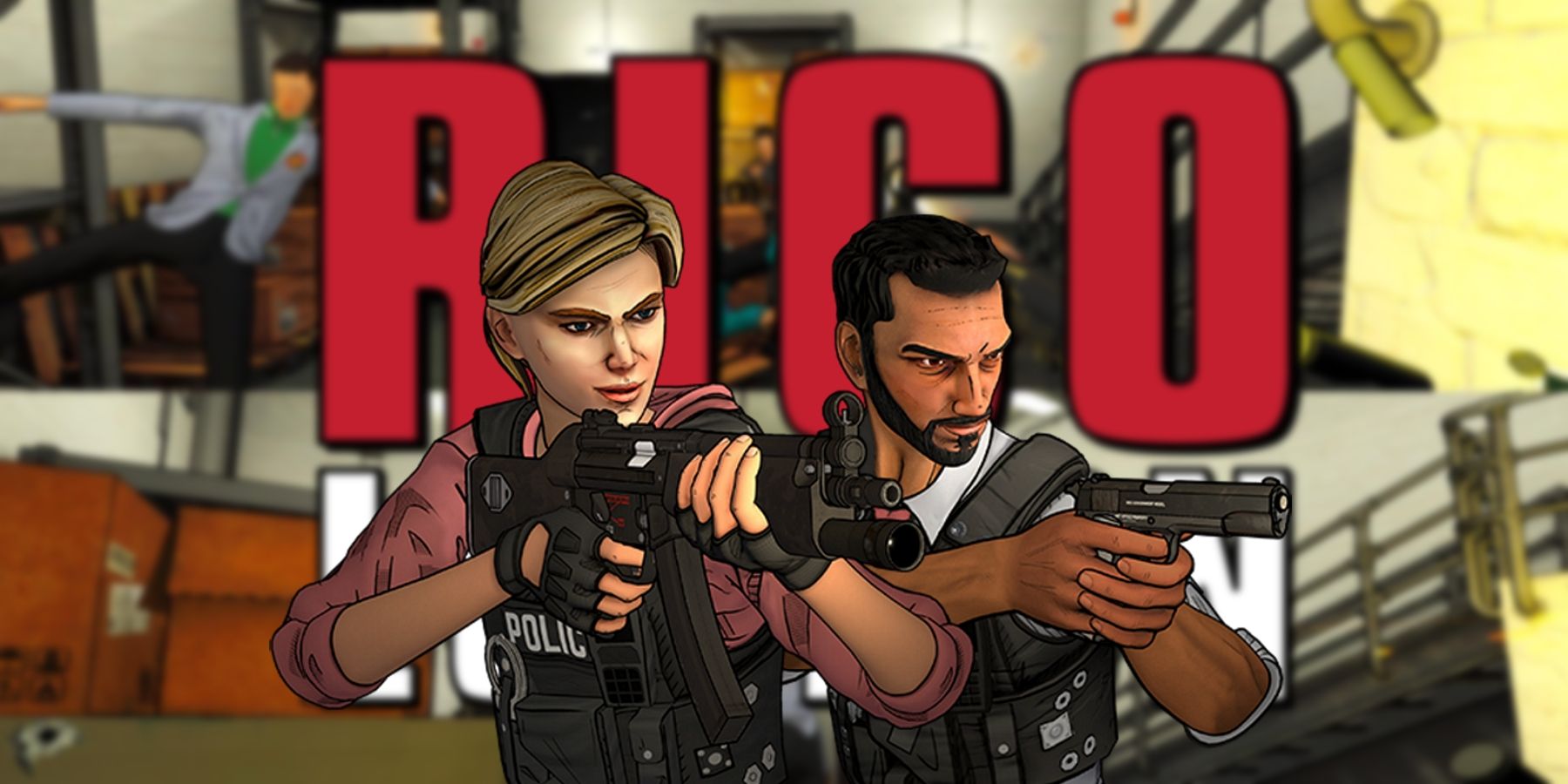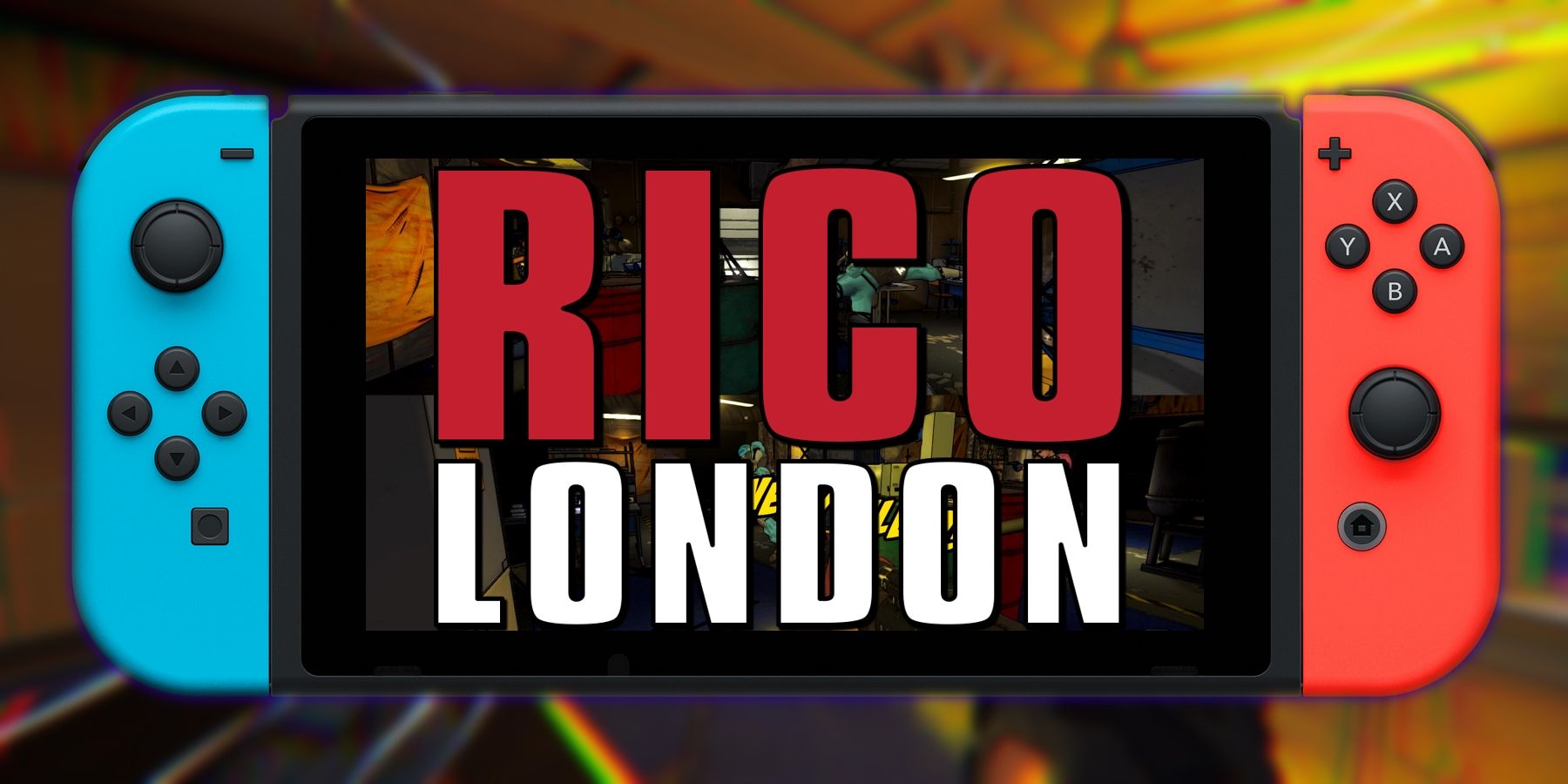RICO London is developer Ground Shatter's latest installment in the RICO series, following the first game released in 2019. It has a cel-shaded, comic book art style reminscent of the older Ubisoft title XIII. As a sequel, the game opts for a much more refined, tight, and much more immediate style of gameplay. Not content with tightening up gameplay, the RICO formula has been condensed into the setting of a monolithic London tower block at the turn of the millenium.
Recently, Game Rant got the chance to sit down with the game's designer, James Parker. Parker had a lot to say about the how the team at Ground Shatter adapted the buddy cop film genre for its cartoony FPS. This included a deeper focus on co-operative play, building the game for the Nintendo Switch first, and the way that dialogue and banter can sometimes disrupt a player's experience. This interview has been edited for brevity and clarity.
Q: What's your ten-word elevator pitch for Rico London?
A: Ten words? That's quite a lot. We normally just go for 'Kick doors, shoot men.' If we get more, I suppose this time it'd be: 'Kick doors, shoot men, up a tower.'
Q: The tower setting in the game is new, and it gives off some JG Ballard High Rise vibes, what made you choose the classic London tower block as a setting?
A: I mean, Die Hard is a fairly obvious one. Also films like Raid or Dredd come to mind - there was a good period where there was a lot of great tower based shooter-action films. From a game perspective as well, it's such a clear and obvious progression. It's clear you're moving from the loading bays at the bottom, through offices, and eventually up to the penthouse for the final showdown. In a way, the progress you make as a player is replicated in the progression you make through a vertical space.
Q: There's always a risk of repetition in a game set in one location, how have you gone about avoiding that with RICO London?
A: I think for the first game, all of the operations took place in seperate buildings. We'd procedurally generate these environments and you'd go in, do your thing, and you'd come out. The whole point of RICO is that the pace is meant to be relentless, so for the sequel we've tried to keep it interesting by having lots of different environments within this one buildings. It's not super realistic, but it's not supposed to be. It's all got that feeling of progression, with new stuff to see as you go through.
Q: How have you incorporated the first game's procedural generation in RICO London?
A: In the first game, we went really hard on that, and had a system that entirely generated everything. With RICO London, we've pulled back slightly on that. The levels are always going to be familiar, but will occur in different orders and formations each time.
What that allowed us to do is have very distinct spaces, and have a lot of distinct visual elements there. It also allowed us to craft the game a lot more. The big thing with RICO London is we've had a lot more resources to put on it, and the story's more important. Everything's a bit more polished and everything has a disctinct place.
Q: Comparing the gameplay between RICO London and the first RICO, this newer title seems to be a lot more dynamic to play. What were the big changes you made to foster this punchier kind of gameplay, and what elements did you purposefully bring forward?
A: It's mostly about immediacy. In the first game, you could only get new weapons when you changed chapters. In the newer game, you can pick weapons up straight away from fallen enemies and you're immediately doing something new.
We've added new movement, there's now a dive alongside the slide we had in previous games. It's really about carrying momentum forward. There's also a new combo score system in pace, too. This means you are rewarded for constantly moving forward, to really reinfoce that immediacy we want in the game.
Q: The cel shaded aesthetic of the game is fairly reminscent of Ubisoft's XIII, which came out a while ago, as does the premise to some degree. Did you have any other major inspirations from video games that you brought to the development of the RICO franchise?
A: The thing I always go back to is Virtua Cop. Not necessarily because it's a genre buddy, because it's not, it's an on-rails shooter. I mainly think of it because at all times, you were only a moment away from shooting down another bad guy. The point of that was to bring you from scene to scene, let you shoot everything in there, and move on. So that cadence of play is something we really wanted RICO to be reminscent of.
We wanted it to be similar to those games like Time Crisis, where there are hundreds of bad guys and you don't know what's happening next, you just have to react to them as they appear. It's about those reaction times, and that sense of moment-to-moment action. RICO does depart from those older games in some ways however, because you can control your character's movement, meaning you get to decide the pace of the fights to some degree.
Q: Was it tricky to naturally implement the slow motion mechanic into such an incredibly fast-paced game?
A: That's more wrapped up in the thing we've tried to do in both games, which is to make you feel like an action star. It's this headcanon of one or two guys against the world, and you're able to react slightly faster than should be possible. We give you that slow motion so you have that moment of advantage after you kick down a door. You get that opportunity to assess the environment, which is what evens the odds between you and these hordes of enemies.
Q: How does the slow motion work in co-op?
A: In the first game, where levels were more spread out, we had a really complex system of how to manage two different sets of slow-mo at the same time. For RICO London, we've simplified it slightly. Part of what we wanted to do with the co-op is still have that sense of immediacy, so most of the time you'll be breaching the same room, either together or from seperate doors.
You'll always be in quite close proximity, which you weren't in the first game. That was sort of a shame, because it stopped that feeling of working back-to-back all the time. It's also made things easier for us tom as it's allowed us to be more generous with the slow motion, and have it a lot more often because players will be a lot more familiar with what their partner is doing at any given time.
Q: In regards to the buddy cop feel that the cooperative mode is going for, did you take any particular narrative inspiration from outside media for it? Did you take the aesthetics, narrative elements, or even tone from classic buddy cop movies, or was it more inspired by UK police procedural series like Line of Duty or Luther?
A: There's bits of both in it, I suppose. One of our big discussions regarding tone has always been if we should have the characters quipping at each other, like you'd get in the best buddy cop movies. My opinion has always been that if you're playing with a friend, you'll be having those conversations in real life. Maybe you'll be making similar comments or quips, while playing the game. In that case, having the characters do it as well will just be a bit much, maybe a bit repetitive.
So, while in this games we have some great dialogue from voice actors, that tends to be more about moving the story on than specifically having banter between the characters. I would rather the players were having that fun for themselves than the characters having it for them.
Q: It's probably unfair to ask your writers to try and compete with two friends bouncing off each other naturally.
A: Exactly that. We also found that when streamers were playing the first game, the best times they had were when they had space to do exactly that.
Q: How heavily did watching streams and Let's Plays of the first game impact the development of RICO London?
A: They mainly just form part of a wider corpus of information we get. Watching someone play your game, as a developer, is so valuable. You can see the points of friction, and what they're enjoying. So, the great part about doing a sequel is you can incorporate that again. We knew part way through RICO that there were things we'd love to do different, missteps we'd redo the next time around, and it was great to incorporate them into this.
Q: What led to the comic book style art used to tell RICO's story?
A: Because we wanted to tell an actual story with this one, we wanted there to be a purpose for going through this world. We've gone even further with the cel shading style of the first game this time around, so it made sense to have comic book panels incorporate that narrative element. We're working with Tom Waterhouse again, who did some stuff for the first game, so he's been helping us with that comic style for the game.
Q: The first game had a much more nebulous setting, like you mentioned. However, RICO London has a particularly loaded setting: London, right at the turn of the millenium, in a tower block/high rise tenement building. These have been quite contentious throughout history, so what made you choose that very specific location (outside of the mechanical points you mentioned earlier)?
A: One of the ideas we had for making a sequel was to do a London based version. I was thinking about the different ways we could link it to the original. So we said that Karen Redford, your handler in first game, as a younger woman, could be a maverick cop on the streets of London. That sort of necessitated us moving it earlier in the timeline, and it got me thinking that actually, the turn of millenium in that place was a really interesting time for those of us who were there.
There was a lot of misplaced hope, all sorts of things going on socially, big parties, and so on. It's a setting that had history without really being historical. It meant we could put up Christmas decorations, signs warning about the millenium bug, and it was just little nods to that world that ties RICO London together and gives it that link to the first RICO.
Q: Is there a favorite Easter egg or visual reference you put in the game that relates to that setting?
A: There's a really nice room set up for an office Christmas party. It's got drinks, stockings on the wall, snacks, and a guy with a machine gun you have to beat. The juxtaposition of those things was really fun.
Q: If you could set a RICO game anywhere, where would it be and why?
A: It's very hard when you're finishing a game to think about anything other than what you're working on. We've done this a bit with our other title, Fights in Tight Spaces, there's certainly the potential for RICO to go to that even more ridiculous Fast and the Furious way with a massive team of global spies.
Q: You mentioned the picking up of weapons, how did you balance the pacing with the scramble for tools and weapons?
A: Essentially, there's a two tier system for gameplay. If you're doing well, you can accrue points that you can spend on shops throughout (it's a very gamey thing, hard to justify in fiction). You can choose from various weapon blueprints, and they can have attachments and the like. So, you'll have your own kind of customized weapon with a bit more ammo.
But, if you find yourself in a tricky situation, and you're strapped for bullets, you can grab a weapon on the ground to keep shooting. They'll be a bit more disposable, and with less ammo - generally the base versions of those weapons. If you need to, you can rely on those for a bit or you can use them as a way of escalating up to the next tier of weapons.
Q: How many weapons can you have at one time, and what's your favorite loadout combination?
A: You have your main weapon, your sidearm, and a throwable like C4 or throwing knives. I like the fact that you can breach open doors with a shotgun, rather than kicking them. It's not necessarily tactically better, but it is very satisfying. I tend to go for a classic pump action shotgun and maybe a silent pistol as my sidearm.
Again, not because of any gameplay benefits, but it just sounds and looks cool. I'm all about the aesthetic over the function. It's all about that action movie ideal: it doesn't matter what you're doing, as long as you look really cool doing it.
Q: On its website, Ground Shatter Games talks a lot about breaking the mold. How important was preserving mechanics like couch co-op, which has maybe fallen to the wayside a bit in the AAA space, for you when developing RICO and its sequel?
A: The couch co-op element certainly was. One of the benefits of being a smaller company is that you can kind of pick and choose what elements you include, and look around to see where you can fit into a gap in the market.
When RICO came out, we had a lot of people saying that it was an experience that wasn't around as much anymore. That ability to sit on the couch with a mate and shoot things was a lot less common. It's nice to be able to fill in a gap for people like ourselves who are after those experiences.
Q: How has the porting process been for RICO London to platforms like the Switch?
A: The thing that we found the first time around is that the game was really popular on Switch. That's because, like we were saying earlier with gaps in the market, the Switch is a bit underserved when it comes to that sort of shooter. We were really lucky with how people responded to it on Switch.
As such, when it came to making RICO London, we knew the limitations and benefits the Switch offered, and we really wanted to lean into that. So, we used it as the base level thing we could do, and used the PC for what the higher-end version of the game might look like.
We always had that opportunity to move between the two, and it was good to know it ran really well on Switch. What we've got this time (which wasn't possible in RICO) is that you can play split-screen co-op even in the tabletop mode. We couldn't do that before because of time and resource limitations. That was really important to us, and it's nice to be able to offer something new to players this time round as well.
Q: If you're designing with the Switch first in mind, what do you keep in mind when doing that? There have been some rather controversial Switch ports of games in the past that were not exactly optimal - what pitfalls do you need to avoid when developing a Switch version of a game?
A: I suppose we just needed to allow the opportunity for other platforms to do what they do as well. We can up the resolution, the framerate, and lighting quality as we go through on to the 'big' consoles, as it were.
I think the mistake that is often made is that people treat the Switch as an afterthought. For us, because the first game had done so well on there, we wanted to kind of reward those players as much as possible while still making it work for us commercially. We also know now how to get the best out of the hardware.
The Switch came out while we were working on RICO, and there's always a learning curve when designing for such new tech. For example, there's stuff for the Switch that can cause problems on other platforms because of the difference in architecture. Learning about what it does well and badly is part of the process.
So, when we were starting from scratch with RICO London, we can think more about what will run well, what will look nice, and what will be scaleable over other platforms as well.
Q: What do you, as a developer, like about the Switch as a platform?
A: What I personally like about it is that everything is so nicely aligned. Everything looks so great on the screen, and particularly with a game like ours, the colors really pop. It's just so nice to actually play a game on Switch and see it look so good.
Q: What can RICO fans look forward to in the future of the franchise?
A: If people like this game when it comes out, we'll keep looking at exactly what they're enjoying and kind of pivot around that! It's been so good to watch how the game has evolved since the first title, and it'll be really exciting to see what players think of it once it's out.
Q: Finally, if you could import any buddy-cop duo from any film franchise to be the lead characters of RICO, who would they be?
A: I always go back to the Bad Boys franchise. I unironically love those films, the first is a brilliant comedy action film, and the second is a fantastic action movie. The third one understands both those things and came out at the right time to make some points about those characters and their place in the world, and has some real affection for the films that came before it. Those characters work so well together, it reinvents the buddy cop concept completely.
RICO London is available now on PC, PlayStation 4, PlayStation 5, Switch, Xbox One, and Xbox Series X/S.

